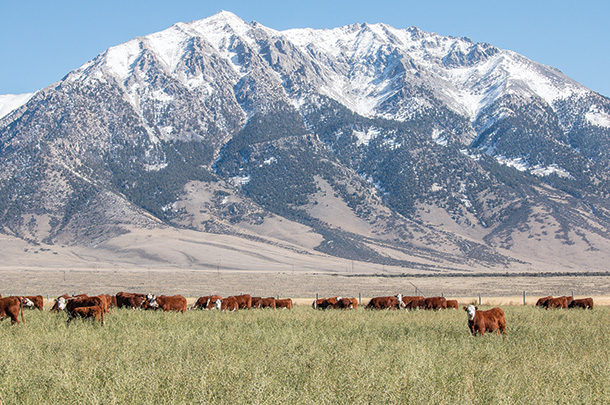There are dozens of decisions to be made in preparing for winter stockers and winter pasture management. I’ve chosen to focus on an input we often forget – risk management.
The state of the current drought in the western U.S. is at historic levels. At the time of writing, 56% of the U.S. was in some stage of drought. In the West and High Plains, 72% and 74% of total area was in some form of drought, with the Drought Severity Coverage Index (DSCI) substantially worse in the western U.S.
The drought brings to mind a need to focus on risk management (although a bit late for some), not only for our outputs (calves) but also for our inputs (feedstuffs). Since we are focusing on winter pasture preparation, this seemed like the perfect opportunity to focus on risk management for forage. Let’s take a look at some strategies for an insurance tool that is growing in popularity – Pasture, Rangeland, Forage (PRF) insurance.
How does it work?
PRF insurance indemnifies producers in a “grid” for deviations from historic average precipitation levels. When we get down to brass tacks, this means that if you insure a percentage of your historic average rainfall in some period, and actual rainfall is less than your insured amount, an indemnity is paid. PRF is unique among federally subsidized crop insurance in that it is not based on county-level measurements. Instead, PRF is based on a grid system made up of grids that are 17X17-mile squares. There are adjustments available within the program for intended use, irrigation, desired coverage level, productivity factors and the insurable interest of the decision-maker. You can purchase PRF through crop insurance providers, who can help you make decisions on tailoring your coverage appropriately. You can also find assistance in determining the appropriate adjustments at USDA - pasture, rangeland, forage support tool.
There are a few strategies worth considering when making your decision. First, you can go to an insurance agent and request equal coverage across all intervals, about 16% per interval (two-month insurable periods that form the basis of PRF coverage). This has some advantages and disadvantages. You will have consistent coverage at all times, with the most likelihood of some payment, and there is little effort required in making your selection. However, with this strategy, your coverage is not maximized based on the data available to us through historic PRF data.
A second strategy is to allocate coverage consistently to the intervals that historically net the most return. For instance, if the February-March, June-July, and September-October intervals historically pay the most, you may net the most return by allocating 33% of your coverage to each of those three intervals. Keep in mind that you can’t insure intervals with overlapping months. PRF was designed with the intent to cover forage growth periods that are the most important to a given grid. However, these intervals are not always the ones that net the most returns in terms of indemnities.
This strategy also has some pros and cons. Your coverage will be closer to its maximized potential based on historic information. However, if an uninsured interval receives less rain while the intervals you selected receive plenty of rain, you could find yourself in the situation of a net loss on PRF while also paying for feed during the dry intervals.
A third, even more advanced, strategy takes into account long-term weather outlooks. It is a rare insurance product that you can forecast a need for. If I knew that I was going to be in a fender bender in 2025 but not before, I’d buy the cheapest accident coverage possible until 2025, then purchase maximum coverage. While we don’t have definite answers on rainfall ahead of time, there are online sources that can give us an idea of expected long-term precipitation when we consider our PRF coverage each year.
I like to use the National Oceanic and Atmospheric Administration’s (NOAA) color maps, which you can find at www.cpc.ncep.noaa.gov/products/forecasts. These maps give a long-term forecast of estimated deviations from normal precipitation for the U.S.; exactly what PRF indemnities are based on. If the June-August color map suggests your region has a high probability of below-average precipitation in the upcoming year, it might be worth allocating a bit of additional coverage to the June-July interval. You can also call down to the local news station and ask your weatherman his or her thoughts. Many of our weathermen in ag country are happy to talk about these questions.
Again, this setup has some pros and cons. Your coverage is closer to its maximized potential based on forecasts, if not your historic information. But if an uninsured interval receives less rain while the intervals you selected receive plenty of rain, you could find yourself shelling out a PRF payment.
What strategy is best for me?
Which strategy you should use depends on your grid. I have worked with operations separated by only a county or two that would benefit from using different strategies. Your risk tolerance will also be a factor. If you prefer a higher likelihood of some payment, equal coverage each year is probably the best bet. If you have a higher tolerance for risk, some of the more advanced strategies may be worth considering.
Give these different strategies some consideration before the sign-up deadline this Nov. 15. Will PRF make your operation whole after a severe drought? No. Will PRF net a profit every year? No. However, if you begin to incorporate a series of safety nets like PRF and disaster assistance payments like the Livestock Forage Program (LFP) into your business planning, you can mitigate climatic risk. Additionally, incorporating some strategy into your insurance purchases might provide more positive outcomes. Over time, this will lower the amount of cash leaving your pocket to pay for supplemental feed and other expenses and hopefully prevent forced liquidations. ![]()
PHOTO: An indemnity is paid when rainfall is less than your insured amount. Photo by Lynn Jaynes.

-
Justin Benavidez
- Assistant Professor - Extension Economist
- Texas A&M
- AgriLife Extension
- Email Justin Benavidez












